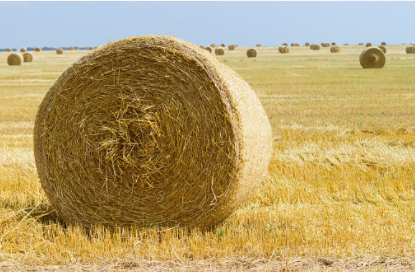For the best results, bale wrap must be made of silage film with a cling layer on the outside of the roll. A good cling level should be between 5 and 10 N/m. The film can also be made using a cast film line, which is simple and quick to do. First, the PIB should be pre-stretched to a moisture content of about 50%-60%. Then, the film is wrapped in layers of two by two squares or a minimum of four.
 The cling layer is critical for a secure seal, so the film used for stapling must be high. SML’s cast film lines typically create five layers of film. In addition, the films have a high stickiness layer, which ensures that they will remain on bales for as long as possible. And, because they are made of virgin LDPE, they will not leave packaging residues on the forage.
The cling layer is critical for a secure seal, so the film used for stapling must be high. SML’s cast film lines typically create five layers of film. In addition, the films have a high stickiness layer, which ensures that they will remain on bales for as long as possible. And, because they are made of virgin LDPE, they will not leave packaging residues on the forage.
For optimal performance, silage film should be highly adherent to the bales. The process used by SML involves using silage film, which is made from five layers. It must adhere well to the bales to ensure a tight seal. The silage film that SML produces is also high-sticky and cling, meaning that it will remain in place even during stapling. This type of film will prevent rodents from gnawing on the wrap and reduce the need for additional plastic.
The students’ idea for bale wrap originated while attending a ploughing match. They have relatives who farm and observe the waste left by farmers. After researching the topic, they decided to develop starches and polymer additives. The film must be able to maintain the airtightness of the bale and must keep out sunlight, rain, and snow. The students also worked with the local universities to develop a closet for wrapping the bale.
The film used for bale wrap must cling to the bales to ensure a tight seal. Therefore, it is ideally made of five film layers, a cling layer. In addition, the UV additive prevents the film from stapling. Therefore, it makes it ideal for use in a silo. Besides preventing the air from penetrating the bale, silage film also protects the animals from damage caused by sunlight.
The film is designed to protect the bales. It should be breathable enough to keep the bales from drying out. If the film is too thin, it will break apart. If it is too thick, the film may cause an unsanitary environment. Despite its weight, it is made of high-quality raw materials. In addition, it offers superior strength durability and is suitable for a wide range of wrappers.
SiloFlex is an affordable premium three-layer bale wrap that offers superior tear resistance, strength, and UV protection. It is made from polymer technology and is an excellent option for hay and round bales. It is designed to withstand the harsh climate. The new film has a high-performance adhesive system to improve adhesion in cold temperatures. Further, it is suitable for bales of higher and heavier weight.
While plastic wrap is the most common type of bale wrap, a new type is available from Austrian manufacturer Coveris. It offers the same protection as coloured bale wrap but greater recycling opportunities. After the bales are wrapped, clear bale wrap sticks to the bales with no tails and is suitable for use on high-performance wrapping machines. The new film is ideal for round bales and can be used with in-line and high-speed machines.
A new adhesive system improves the film’s ability to withstand cold temperatures. Its unique adhesive system provides good adhesion even in extremely cold temperatures. It also prevents tails, and it allows for increased production rates. The new film is compatible with high-performance wrapping machines, as it is strong and durable. It is also more durable than traditional bale wrap. In addition, the film is resistant to puncture and is easy to cut, ensuring that it does not tear or stretch during shipping.
